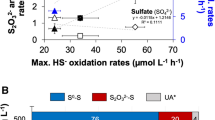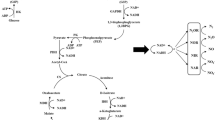Abstract
The capacity of two anaerobic consortia to oxidize different organic compounds, including acetate, propionate, lactate, phenol and p-cresol, in the presence of nitrate, sulfate and the humic model compound, anthraquinone-2,6-disulfonate (AQDS) as terminal electron acceptors, was evaluated. Denitrification showed the highest respiratory rates in both consortia studied and occurred exclusively during the first hours of incubation for most organic substrates degraded. Reduction of AQDS and sulfate generally started after complete denitrification, or even occurred at the same time during the biodegradation of p-cresol, in anaerobic sludge incubations; whereas methanogenesis did not significantly occur during the reduction of nitrate, sulfate, and AQDS. AQDS reduction was the preferred respiratory pathway over sulfate reduction and methanogenesis during the anaerobic oxidation of most organic substrates by the anaerobic sludge studied. In contrast, sulfate reduction out-competed AQDS reduction during incubations performed with anaerobic wetland sediment, which did not achieve any methanogenic activity. Propionate was a poor electron donor to achieve AQDS reduction; however, denitrifying and sulfate-reducing activities carried out by both consortia promoted the reduction of AQDS via acetate accumulated from propionate oxidation. Our results suggest that microbial reduction of humic substances (HS) may play an important role during the anaerobic oxidation of organic pollutants in anaerobic environments despite the presence of alternative electron acceptors, such as sulfate and nitrate. Methane inhibition, imposed by the inclusion of AQDS as terminal electron acceptor, suggests that microbial reduction of HS may also have important implications on the global climate preservation, considering the green-house effects of methane.






Similar content being viewed by others
References
Achtnich C, Bak F, Conrad R (1995) Competition for electron donors among nitrate reducers, ferric iron reducers, sulphate reducers and methanogens in anoxic paddy soil. Biol Fertil Soils 19:65–72
Anderson RT, Lovley DR (2000) Anaerobic bioremediation of benzene under sulfate-reducing conditions in a petroleum-contaminated aquifer. Environ Sci Technol 34:2261–2266
Benz M, Schink B, Brune A (1998) Humic acid reduction by Propionibacterium freudenreichii and other fermentative bacteria. Appl Environ Microbiol 64:4507–4512
Bradley PM, Chapelle FH, Lovley DR (1998) Humic acids as electron acceptors for anaerobic microbial oxidation of vinyl chloride and dichloroethene. Appl Environ Microbiol 64:3102–3105
Bruce RA, Achenbach LA, Coates JD (1999) Reduction of (per)chlorate by a novel organism isolated from paper mill waste. Environ Microbiol 1:319–329
Cervantes FJ, de Bok FAM, Duong-Dac T, Stams AJM, Lettinga G, Field JA (2002) Reduction of humic substances by halorespiring, sulphate-reducing and methanogenic microorganisms. Environ Microbiol 4:51–57
Cervantes FJ, Dijksma W, Duong-Dac T, Ivanova A, Lettinga G, Field JA (2001) Anaerobic mineralization of toluene by enriched sediments with quinones and humus as terminal electron acceptors. Appl Environ Microbiol 67:4471–4478
Cervantes FJ, Duong-Dac T, Roest K, Akkermans ADL, Lettinga G, Field JA (2003) Enrichment and immobilization of quinone-respiring bacteria in anaerobic granular sludge. Water Sci Technol 48(6):9–16
Cervantes FJ, van der Velde S, Lettinga G, Field JA (2000a) Competition between methanogenesis and quinone respiration for ecologically important substrates in anaerobic consortia. FEMS Microbiol Ecol 34:161–171
Cervantes FJ, van der Velde S, Lettinga G, Field JA (2000b) Quinones as terminal electron acceptors for anaerobic microbial oxidation of phenolic compounds. Biodegradation 11:313–321
Cervantes FJ, Vu-Thi-Thuy L, Lettinga G, Field JA (2004) Quinone-respiration improves dechlorination of carbon tetrachloride by anaerobic sludge. Appl Microbiol Biotechnol 64:702–711
Coates JD, Ellis DJ, Roden E, Gaw K, Blunt-Harris EL, Lovley DR (1998) Recovery of humics-reducing bacteria from a diversity of sedimentary environments. Appl Environ Microbiol 64:1504–1509
dos Santos AB, Bisschops IAE, Cervantes FJ, van Lier JB (2004) Effect of different redox mediators during thermophilic azo dye reduction by anaerobic granular sludge and comparative study between mesophilic (30 °C) and thermophilic (55 °C) treatments for decolourisation of textile wastewaters. Chemosphere 55:1149–1157
Field JA, Cervantes FJ (2005) Microbial redox reactions mediated by humus and structurally related quinones. In: Perminova IV, Hatfield K, Hertkorn N (eds) Use of humic substances to remediate polluted environments: from theory to practice. Springer, The Netherlands
Field JA, Cervantes FJ, van der Zee FP, Lettinga G (2000) Role of quinones in the biodegradation of priority pollutants: a review. Water Sci Technol 42(5–6):215–222
Holmer M, Kristensen E (1994) Coexistence of sulphate reduction and methane production in an organic-rich sediment. Mar Ecol Prog Ser 107:177–184
Hutchins SR, Sewell GW, Kovacs DA, Smith GA (1991) Biodegradation of aromatic hydrocarbons by aquifer microorganisms under denitrifying conditions. Environ Sci Technol 25:68–76
Kappler A, Benz M, Schink B, Brune A (2004) Electron shuttling via humic acids in microbial iron(III) reduction in a freshwater sediment. FEMS Microbiol Ecol 47:85–92
Kostka J, Nealson KH (1998) Isolation, cultivation and characterization of iron- and manganese-reducing bacteria. In: Burlage RS, Atlas R, Stahl D, Geesey G, Sayler G (eds) Techniques in microbial ecology. Oxford University Press, New York
Lovley DR (1985) Minimum threshold for hydrogen metabolism in methanogenic bacteria. Appl Environ Microbiol 49:1530–1531
Lovley DR, Coates JD, Blunt-Harris EL, Phillips EJP, Woodward JC (1996) Humic substances as electron acceptors for microbial respiration. Nature 382:445–448
Lovley DR, Dwyer DF, Klug MJ (1982) Kinetic analysis of competition between sulphate reducers and methanogens for H2 in sediments. Appl Environ Microbiol 430:1373–1379
Lovley DR, Fraga JL, Blunt-Harris EL, Hayes LA, Phillips EJP, Coates JD (1998) Humic substances as a mediator for microbially catalyzed metal reduction. Acta Hydrochim Hydrobiol 26:152–157
Lovley DR, Fraga JL, Coates JD, Blunt-Harris EL (1999) Humics as an electron donor for anaerobic respiration. Environ Microbiol 1:89–98
Lovley DR, Kashefi K, Vargas M, Tor JM, Blunt-Harris EL (2000) Reduction of humic substances and Fe(III) by hyperthermophilic microorganisms. Chem Geol 169:289–298
Newman DK, Kolter R (2000) A role for excreted quinones in extracellular electron transfer. Nature 405:94–97
Oude-Elferink SJWH, Vorstman WJC, Sopjes A, Stams AJM (1998) Characterization of the sulfate-reducing and syntrophic population in granular sludge from a full-scale anaerobic reactor treating papermill wastewater. FEMS Microbiol Ecol 27:185–194
Roest K, Heilig HGHJ, Smidt H, de Vos WM, Stams AJM, Akkermans ADL (2005) Community analysis of a full-scale anaerobic bioreactor treating paper mill wastewater. Syst Appl Microbiol 28:175–185
Roy R, Klüber HD, Conrad R (1997) Early initiation of methane production in anoxic rice soil despite the presence of oxidants. FEMS Microbiol Ecol 24:311–320
Scheid D, Stubner S, Conrad R (2003) Effects of nitrate- and sulphate-amendments on the methanogenic populations in rice root incubations. FEMS Microbiol Ecol 43:309–315
Scholten JCM, van Bodegom PM, Vogelaar J, van Ittersum A, Hordijk K, Roelofsen W, Stams AJM (2002) Effect of sulfate and nitrate on acetate conversion by anaerobic microorganisms in a freshwater sediment. FEMS Microbiol Ecol 42:375–385
Scott DT, McKnight DM, Blunt-Harris EL, Kolesar SE, Lovley DR (1998) Quinone moieties act as electron acceptors in the reduction of humic substances by humics-reducing microorganisms. Environ Sci Technol 32:2984–2989
Stevenson FJ (1994) Humus chemistry: genesis, composition, reactions. Wiley, New York
Stone AT, Morgan JJ (1984) Reduction of manganese(III) and manganese(IV) oxides by organics. 1. Reaction with hydroquinone. Environ Sci Technol 18:450–456
van Bodegom PM, Scholten JCM, Stams AJM (2004) Direct inhibition of methanogenesis by ferric iron. FEMS Microbiol Ecol 49:261–268
van Bodegom PM, Stams AJM (1999) Effects of alternative electron acceptors and temperature on methanogenesis in rice paddy soils. Chemosphere 39:167–182
Acknowledgments
This research was financially supported by the Council of Science and Technology of Mexico (Grant SEP-CONACYT-C02-43144). The technical assistance of Luis A. López and Ciria B. Cota-Navarro is greatly appreciated.
Author information
Authors and Affiliations
Corresponding author
Rights and permissions
About this article
Cite this article
Cervantes, F.J., Gutiérrez, C.H., López, K.Y. et al. Contribution of quinone-reducing microorganisms to the anaerobic biodegradation of organic compounds under different redox conditions. Biodegradation 19, 235–246 (2008). https://doi.org/10.1007/s10532-007-9130-x
Received:
Accepted:
Published:
Issue Date:
DOI: https://doi.org/10.1007/s10532-007-9130-x




